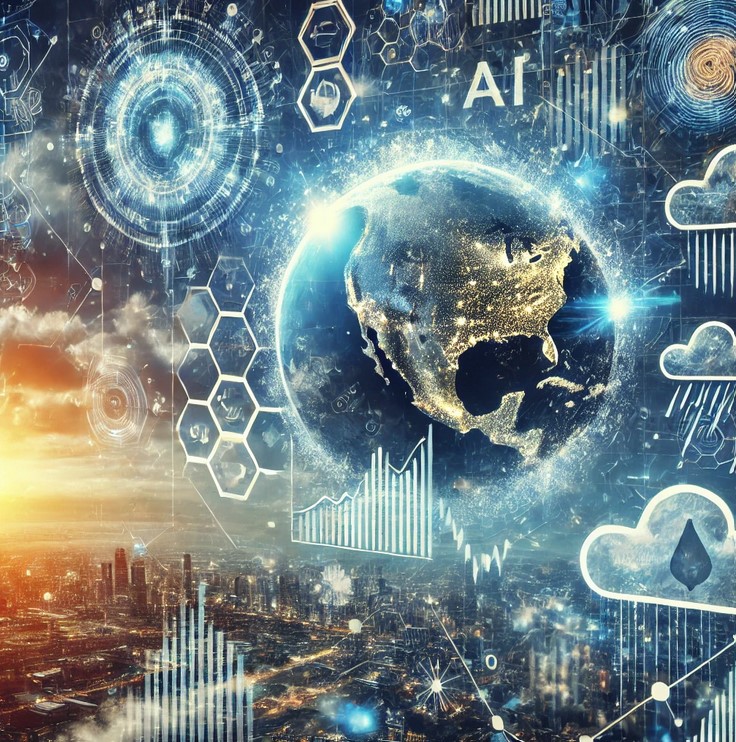(GOOG), (GOOGL), (NVDA), (TMC), (DE), (CTVA), (NEE), (FSLR), (UNP), (FDX)
"If you don't like the weather, wait five minutes, and it will change.” This old adage has long been a humorous nod to the weather's fickle nature.
But what if you didn't have to wait? What if you could predict that change before it happened?
Weather prediction has come a long way since the first computerized forecast in 1950. Today, we're looking at a global weather forecasting system market worth a cool $2.7 billion. That's as of 2023, mind you.
By 2029? It’s projected to hit $4.2 billion. Growth like that doesn't just fall from the sky.
Traditional weather models have been the heavyweights for years. The European Centre for Medium-Range Weather Forecasts (ECMWF) and the U.S. National Weather Service's Global Forecast System (GFS) are titans in the field.
They crunch numbers on supercomputers that make your latest smartphone look like a pocket calculator. Take the Cray XC40 used by ECMWF. It's pumping out quadrillions of calculations per second. Impressive, right?
But here's the catch. These models aren't perfect. Far from it. Generating a single forecast can take hours. Hours. In the fast-paced world of weather, that's an eternity.
By the time the forecast is ready, Mother Nature’s already changed her mind. It's like trying to catch a greased pig – frustrating and often futile.
A 2021 study in the Journal of Geophysical Research laid it out plain as day. ECMWF and GFS? They're reliable for short-term forecasts, up to about 10 days.
Beyond that? Their crystal ball gets mighty cloudy. And when it comes to extreme weather, they're often caught with their pants down.
Case in point: Hurricane Beryl in 2024. This Category 5 monster decided to crash the party in early July, becoming the earliest Atlantic storm of its kind on record.
Instead of heading to Mexico as predicted, it decided Texas looked more appealing, leaving a trail of destruction in its wake.
But it's not just hurricanes keeping forecasters up at night. The World Meteorological Organization confirmed 2023 as the hottest year on record.
Global temperatures soared 1.15°C above pre-industrial averages. July 3, 2023? Possibly the hottest day ever recorded globally. Talk about turning up the heat.
The National Oceanic and Atmospheric Administration (NOAA) paints an even grimmer picture. In 2023, the U.S. was hit by 28 weather and climate disasters. Each one racked up at least $1 billion in damages. That ties the record set in 2020. Climate change isn't just knocking at the door – it's kicking it down.
Enter artificial intelligence (AI).
DeepMind's GraphCast is making waves in the forecasting world. It's churning out global weather forecasts in less than a minute. You read that right. Seconds, not hours.
In fact, a 2023 study in Science found GraphCast outperformed ECMWF's high-resolution prediction system in 90% of 1,380 evaluation metrics. That's not just beating the competition – it's lapping them.
But GraphCast isn't the only AI superstar in town.
DeepMind's NeuralGCM combines traditional physics-based methods with machine learning. The result? Potentially game-changing long-range predictions.
We're talking climate patterns decades into the future. Imagine the implications for long-term planning and investment strategies.
These AI models are weather savants. They devour vast amounts of historical data, using advanced neural networks to learn complex atmospheric patterns.
The payoff? More accurate predictions, delivered faster than you can say "partly cloudy with a chance of meatballs."
Needless to say, these are opening up a whole new world of possibilities.
We're talking personalized, hyperlocal forecasts. Better extreme weather warnings. More effective climate change modeling. Where there's innovation, there's opportunity.
Let's break it down with some numbers that really matter. A study in the Journal of Advances in Modeling Earth Systems (2022) found AI models could potentially extend reliable hurricane track predictions from 3 to 5 days in advance.
Two extra days of preparation time. Crucial for both safety and economic reasons.
Speaking of economics, the U.S. National Hurricane Center estimates each mile of coastline evacuated costs about $1 million.
More accurate forecasts could mean fewer unnecessary evacuations. Millions saved. And it's not just about saving money. It's about using resources more effectively.
The Federal Emergency Management Agency (FEMA) reported that pre-positioning resources for Hurricane Irma in 2017 saved an estimated $100 million in recovery costs. Better forecasts mean better resource allocation.
So, where's the smart money going?
Keep your eyes on tech giants like Alphabet (GOOGL, GOOG), parent company of DeepMind. Market cap of $1.75 trillion. Q2 2024 revenue of $88.3 billion, up 15% year-over-year.
Don't forget about NVIDIA (NVDA). Their GPUs are the workhorses powering these AI models. FY 2024 revenue? $60.9 billion. That's a 126% year-over-year growth.
But it's not just about the tech giants.
Companies like The Tomorrow Companies Inc. (TMC) are specializing in AI-powered weather forecasting services. Market cap of $2.1 billion. 2023 revenue of $450 million, up 35% year-over-year. They're proving that sometimes, it pays to be a specialist.
And let's not overlook the industries that stand to benefit from better forecasts.
Agriculture giants like Deere & Company (DE) and Corteva Inc. (CTVA) are integrating weather data into their precision agriculture solutions.
In the energy sector, companies like NextEra Energy (NEE) and First Solar (FSLR) are using improved weather predictions to optimize renewable energy production.
Even transportation companies like Union Pacific Corporation (UNP) and FedEx Corporation (FDX) stand to gain. Weather-related disruptions cost the transportation industry billions annually. Better forecasts could lead to significant efficiency improvements.
The bottom line? The AI revolution in weather forecasting isn't just changing how we predict the weather. It's creating a perfect storm of investment opportunities across multiple fields.
I advise you to keep a close watch on this sector because we all know that sometimes the biggest opportunities come from seeing which way the wind is blowing before everyone else does.
And right now, that wind is blowing towards AI-powered weather forecasting. Don't get left out in the cold.


